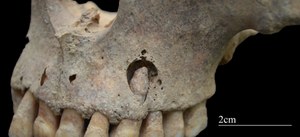From Oracle to Human Bones: Documenting Health in Late Shang, China
This article appeared in ISAW Newsletter 23, Winter 2019.
 A large periapical abscess in the maxilla of a Bronze Age individual
Inscriptions on oracle bones document ritual divinations carried out by the elite members of society during China’s Late Shang period (ca. 1250-1050 BCE). These inscriptions include health-related issues, such as a series of divinations seeking to identify which ancestor was causing King Wu Ding’s “sick tooth” in order to provide a conciliatory sacrificial offering. While we cannot directly diagnose the maladies that appear in the paleographic record, bioarchaeological analyses of human skeletal remains from the core site of Yinxu in Anyang city, Henan province have revealed a suite of possible candidates for the cause of Wu Ding’s toothache. Specifically, widespread caries (cavities), abscesses, and periodontal disease have all been documented among the population. These pathologies would not only have been extremely painful, but could ultimately result in tooth loss – or worse.
A large periapical abscess in the maxilla of a Bronze Age individual
Inscriptions on oracle bones document ritual divinations carried out by the elite members of society during China’s Late Shang period (ca. 1250-1050 BCE). These inscriptions include health-related issues, such as a series of divinations seeking to identify which ancestor was causing King Wu Ding’s “sick tooth” in order to provide a conciliatory sacrificial offering. While we cannot directly diagnose the maladies that appear in the paleographic record, bioarchaeological analyses of human skeletal remains from the core site of Yinxu in Anyang city, Henan province have revealed a suite of possible candidates for the cause of Wu Ding’s toothache. Specifically, widespread caries (cavities), abscesses, and periodontal disease have all been documented among the population. These pathologies would not only have been extremely painful, but could ultimately result in tooth loss – or worse.
Bioarchaeology is well-suited to identify periods of health and nutritional stress occurring across a person’s lifetime. For example, dental defects can record episodes of physiological stress during childhood. Deficiencies in vitamins and minerals – often exacerbated by chronic infection – also leave lasting signatures on the skeleton. While the in-depth study of one individual can inform us about their lived experiences, putting a face to the ancient world, population-wide studies can communicate larger social trends and trajectories in health. When integrated with the paleographic record and archaeological evidence from nearly a century of systematic excavations at Yinxu, the bioarchaeological research carried out by myself and other scholars can contribute to our overall understanding of the dynamic interplay between health and the socio-political, cultural, and economic conditions of Bronze Age China.